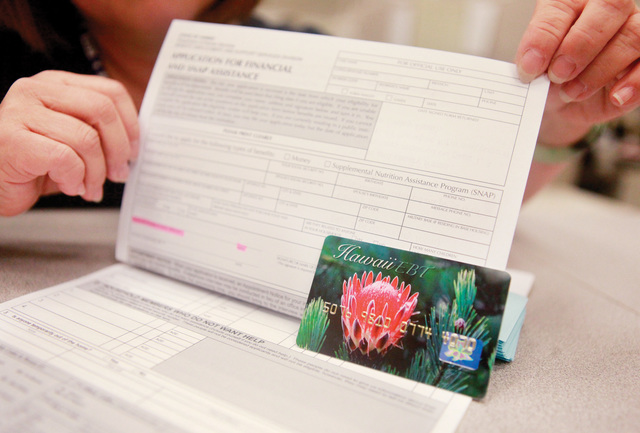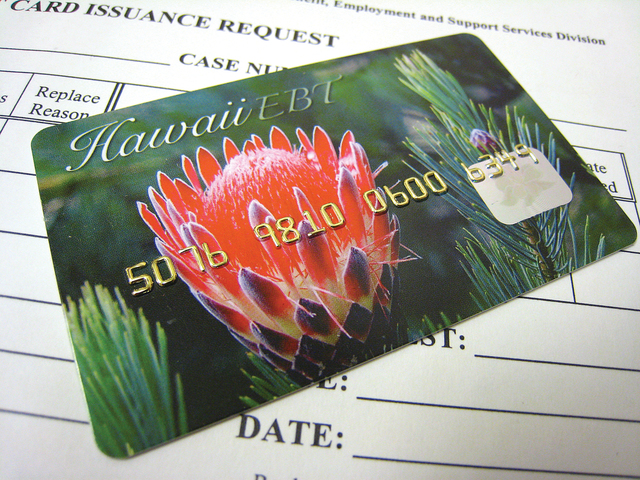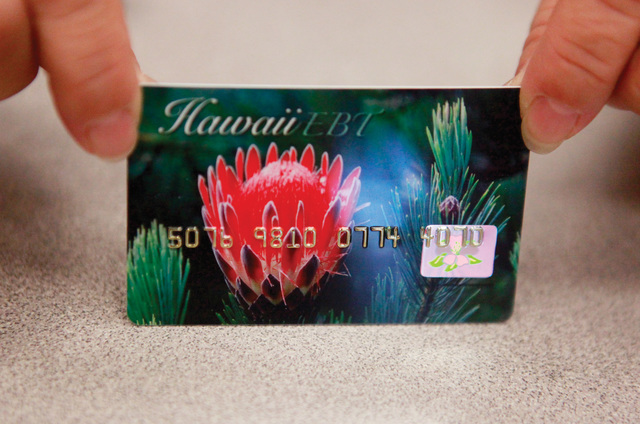After six years of rising participation in the federal Supplemental Nutritional Assistance Program, Hawaii County’s numbers are beginning to drop off. But state officials attribute the cause to changing federal regulations rather than a decrease in need. ADVERTISING After six
After six years of rising participation in the federal Supplemental Nutritional Assistance Program, Hawaii County’s numbers are beginning to drop off. But state officials attribute the cause to changing federal regulations rather than a decrease in need.
Participation in SNAP (formerly known as food stamps) increased yearly from 2008 to 2014, according to the state Department of Human Services, which oversees the program.
Still, monthly records from this year show that participation in SNAP has dropped by about 500 households from January to April. As of April there were 19,198 households enrolled, and a total of 39,021 people.
A spokesperson for the department could not identify any definite reasons for the drop, but said it may be “partially attributed” to a reinstatement of a federal policy mandating that unemployed, able-bodied people receiving SNAP benefits can only do so for three months. Hawaii was one of many states to qualify for and use waivers of the policy once the suspension had ended, but the final waiver period ended in December 2014.
On the surface, statewide participation in SNAP is on par with national trends. A February report by the Center on Budget and Policy Priorities found that last year about 14 percent of the state population used the program, slightly less than the national participation rate of 15 percent.
But many residents who are eligible don’t even realize it and never sign up. A 2014 study by the Hawaii Appleseed Center for Law and Economic Justice that ranked the state 49th in the country for participation, estimating that one of three eligible families isn’t using the SNAP program at all.
“That’s the challenge, is just getting that word out,” said Brandee Menino, CEO for Hope Services Hawaii. Hope Services, a nonprofit that addresses housing and homelessness, contracts with DHS to increase SNAP outreach.
Until this year, Hope Services had just one outreach worker for the entire county. The staff expanded to two this year, with the goal of enrolling 800 new participants.
The basic criteria for a household’s SNAP eligibility is income that falls at or below 130 percent of the federal poverty line. People receiving federal Temporary Assistance to Needy Families are also automatically eligible. Other criteria such as citizenship also apply, making document collection and verification the most time-consuming part of filling out an application.
Even when people do find out they are eligible for SNAP, there can still be reluctance to apply for the program. In some cases, it’s logistics. In others, it’s more about pride.
“The paperwork is cumbersome, or they feel like, ‘The next person will need that more than I do,’” Menino said. The latter is more common among elderly people, she said.
“There’s a stigma surrounding the SNAP program,” Menino said. “People automatically think if they’re working, they’re not eligible … (but) it can help stretch your dollar on a monthly budget.”
In April, the average monthly benefit per person in Hawaii County was $227.77.
A different stigma is present among those who do not need to apply for the program.
“They have a difficult time grasping that SNAP is for those who are most in need,” Menino said. She said she hears from community members who believe SNAP users don’t use their dollars “efficiently and effectively.”
To that end, the outreach workers also work on education efforts: how to create better budgets and shop for healthier foods.
The Food Basket, a main source for emergency food on Hawaii Island, launched a community-supported agriculture program last year that provides SNAP recipients with fresh, local fruits and vegetables. It’s also one of the places outreach workers visit in their efforts to get the SNAP word out (homeless shelters, community centers and thrifts shops are also visited).
Hope Services Hawaii uses radio ads to spread the word even further. Menino says the ads emphasize that bringing in SNAP funding benefits an entire community because of the dollars that are put into the economy.
“It’s trying to show the big picture,” she said.
E-mail Ivy Ashe at iashe@hawaiitribune-herald.com.





